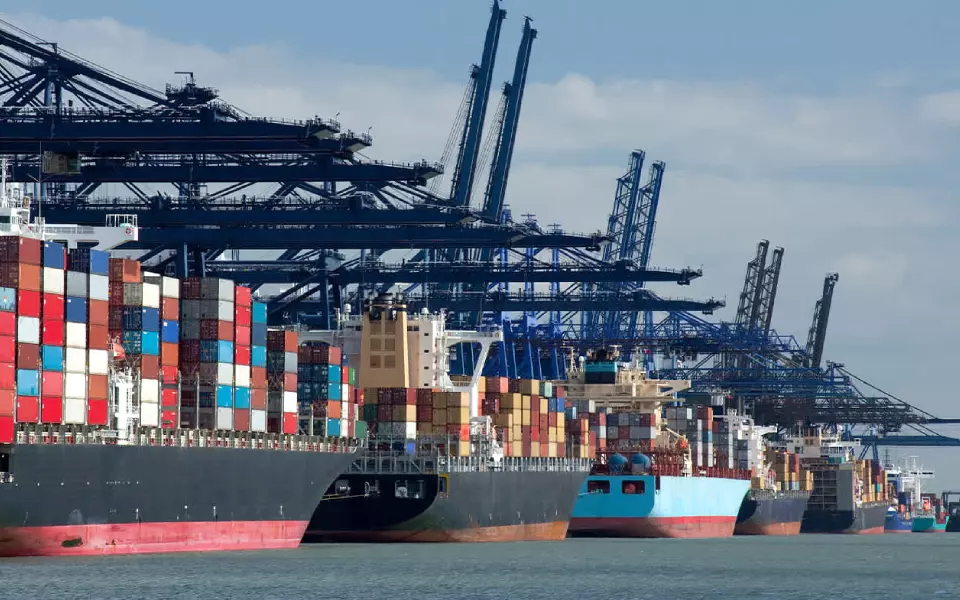Most container ports are open 365 days a year and some ports even operate 24 hours a day. Efficiency in container port operations is essential, as it allows terminals to maximize container throughput to facilitate global trade demands.
Container ports that operate efficiently also help to reduce vessel turnaround times, streamline operational processes, expedite cargo movement, and reduce port congestion.
Port congestion occurs when a port is not able to facilitate all of the vessels that require container loading and unloading. This means some vessels are required to anchor in open waters or decrease their speed in transit, as there are not enough berths available for docking.
This can lead to delays in ship arrivals, extended waiting times for vessels, increased dwell times for cargo, and overall supply chain disruptions. In this scenario, shipping lines may charge a congestion surcharge.

A congestion surcharge sometimes called a port congestion surcharge, is an accessorial fee imposed by shipping lines to the cargo owner, to cover expenses and losses incurred due to port congestion and related operational challenges.
Operational costs can include additional fuel consumption, labor charges, port stay supplies, and protection from possible cargo claims where compensation may be paid to clients affected by delays.
When port congestion occurs, major delays disrupt vessel schedules and vessel rotation or shipping lines. Therefore, carriers tend to face additional operating costs while trying to meet their service commitments to their customers.
How Much Do Carriers Charge?
A Congestion Surcharge is typically included in the carrier’s invoice and falls under accessorial charges. Unfortunately, carriers do not have uniform rates for this type of surcharge.
The basis of this fee is dependent on the severity of congestion, the location of the port, and the type of carrier. Congestion surcharges are typically charged by container type and can range anywhere between $300 to $500 per 20-foot container and about $600 to $1,000 per 40-foot container.
However, as stated earlier, it’s important to always check these rates beforehand, as each carrier may have a different rate or fee structure.
What Can Cause Carriers to Charge Congestion Surcharges?
There are various reasons why ports can get congested. Most congestions happen due to high vessel or cargo throughput,
- High Throughput – High container throughput can lead to port congestion due to the influx of arriving vessels, which in turn overwhelms the operational capacity of seaports. When a significant number of vessels arrive within a short span of time, it can strain the available berths, port cranes, and handling equipment. This can result in delays, particularly in the unloading and loading of containers. Moreover, this congestion often translates into waiting times at anchor, longer dwell periods for containers within the terminal, and disruptions in vessel scheduling processes of shipping lines.
- Insufficient Berths – Insufficient berths can also be a significant driver of port congestion, as it limits the number of vessels that can be accommodated. When the demand for berthing space surpasses the available capacity, ships might have to wait at anchor (often near the port), leading to delays in cargo operations and vessel schedules. Ports operators spend a tremendous amount of time, resources, and capital to plan and expand port terminals to accommodate a large number of vessels. However, cargo throughput is hard to predict, as these projections are often influenced by global trade and market trends.
- Port Strikes – Port strikes can cause port congestion by disrupting cargo handling due to a shortage of essential labor during this period, leading to further delays in loading and unloading container vessels. Port operators rely on skillful personnel to operate cranes and container handling equipment that moves containers within the port.
- Adverse Weather – Extreme weather conditions such as storms, snow, heavy winds, and strong currents can contribute to slower vessel turnaround, which in turn lowers the overall container throughput. While these adverse weather conditions are only temporary, they can strain the resources required to load and unload vessels, as well as cause port congestion.
- Infrastructure Limitations – Limitations to the port infrastructure can cause port congestion by constraining the port’s ability to accommodate the growing demands of facilitating vessels, moving containers within the terminal, and facilitating container pickups and dropoffs by trucks. Moreover, inadequate road and rail connections, insufficient container storage space, and outdated handling equipment can hinder efficient cargo movement within the port, further exacerbating port congestion.
Can These Surcharges Be Waived?
In essence, carriers need to generate enough revenue to remain profitable. This means that most of the charges they incur due to port congestion are passed on to the party that pays for the ocean freight.
For those reasons, carriers typically do not waive congestion surcharges, as they are designed to offset additional fees imposed by the port operator and other third parties, such as additional fuel consumption, supplies, insurance, and more.
However, cargo owners that move a significant amount of volume with a particular carrier may be able to negotiate lower congestion surcharges.

Get Free Course Access
If you enjoyed the article, don’t miss out on our free supply chain courses that help you stay ahead in your industry.

Gerrit Poel
Co-Founder & Writer
at freightcourse
About the Author
Gerrit is a certified international supply chain management professional with 16 years of industry experience, having worked for one of the largest global freight forwarders.
As the co-founder of freightcourse, he’s committed to his passion for serving as a source of education and information on various supply chain topics.
Follow us